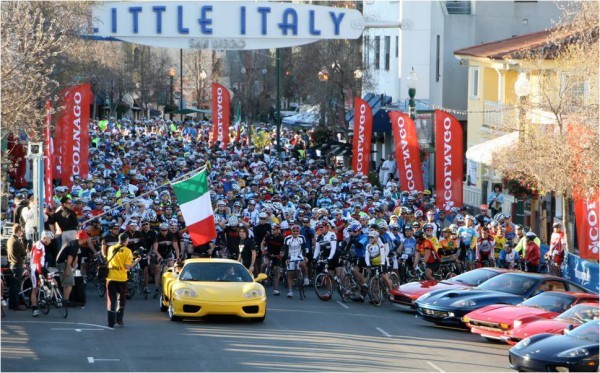You’ve probably heard about the Gran Fondo by now — but what is a gran fondo? Any Italian can tell you what a Gran Fondo is but you probably won’t get a straight answer from most American cyclists but it’s no real surprise. The first real “Gran Fondo” in North America was held only a few years ago. Many of today’s “Gran Fondos” have nothing but the name in common.
What is a Gran Fondo?
It’s like a marathon for cyclists. The riders at the front compete for the win, the riders in the middle go for a personal record, and the riders in the back aim to beat the cut-off time. So what is a Gran Fondo? A Gran Fondo is a personal challenge where each participant does his or her best.
Bike Racing Versus Fondo
Unless you’re a trained athlete, racing is not a good participation sport. Traditional bike racing differs from a Gran Fondo in one specific area. If you get dropped from the bunch you ride back all by yourself. You’re either in or you’re out.
It’s All About the Clock
A Gran Fondo is designed to solve the participation issue by making a bike race more like a marathon. Rather than racing against other cyclists, you use the Gran Fondo to challenge yourself against the clock. The distance is usually tough enough to make you proud of simply finishing.
Timing Chip
A real Gran Fondo has a competitive element — all riders are individually timed with a timing chip and the event provides the rankings based on time from start to finish. The rider is timed against the clock and then compared to the other competitors to determine placement. Technically speaking, if you don’t have a chip, you’re really not riding in an authentic Gran Fondo, no matter what it’s called.
Routes and Standings
Gran Fondo events typically range from between 30 to 100-mile routes (48-160 kilometers). The 100-mile routes are where the titles are earned and the rules are simple. Each 100-mile route has four chip-timed sections. The lowest cumulative time of all four sections decides the day’s winner across any of 10 categories. Individual event placings are equal to points for series standings. First place on day one takes one point, second place two points, etc. Cyclists must attend at least three events to qualify for a title and standings are determined by adding the three lowest scores together, with the lowest score winning.
No Maps
The full route of a Gran Fondo is required to be marked in such a way that it can be ridden by someone without a cue sheet and is not familiar with the area. Gran Fondo organizers provide distance signs that indicate length and gradient of key climbs. If you are given or in possession of a cue sheet or map to orientate, you are not riding in an authentic Gran Fondo.
Gran Fondo is a Closed Course
Difference in course control also means that a real Gran Fondo is much more expensive than an organized group ride. In Italy for example, course control is done by volunteer marshals. In North America, only police officers are allowed to direct traffic and closing roads is expensive.
Lights and Stop Signs
While thorough road closures are desirable, they are rarely possible. Moderated traffic is very important to providing cyclists the right of way. In North America, every traffic light and stop sign has to be manned by a police officer in order to overwrite traffic rules in favor of the rider. If you have to stop at lights and stop signs, you are likely not riding in an authentic Gran Fondo, no matter what they call it.
Three Key Elements
Authentic Gran Fondos are few and far between in the United States. If you want to get picky about it before you register, ask the organizer to provide the three key elements of timing, controlled traffic, and course signage.
More Like a Party
Technicalities aside, the American version of the Gran Fondo is more like a party than a competitive event. It is sometimes referred to as a cyclosportive. It does however incorporate some of the authentic Gran Fondo characteristics depending on the planning of the event.
Common Similarities
You should expect generic Gran Fondos to have a mass-start and fall somewhere between a race and a casual group ride. It should be complete with with race numbers, aid stations, and course marshaling. Only a few participants will realize a realistic chance at crossing the finish line first. Others will be content to just complete the distance. Racing licenses are typically not required and insurance should be provided through event organizers and covered in registration fees.
Charity Rides
Unless you have your heart set on an authentic Italian Gran Fondo, you’re more likely to get a North American version. Charity organizations have embraced the Gran Fondo concept as a way to raise money for cancer, diabetes, and a wide range of other causes.
Go For It
Now that you know the answer to “What is a Gran Fondo”, what’s the harm in taking a scenic, challenging ride in the country with hundreds or thousands of other cyclists ranging from pros to eighty-year-old cyclists? Mix in mechanical and medical support, feed zones with sandwiches, fruit and drinks, traffic control and enthusiastic supporters; you can’t miss with any Gran Fondo. The organizers of any kind of Gran Fondo are to be applauded for bringing organized cycling events to the masses. If you get a chance to sign up for one — do it.

